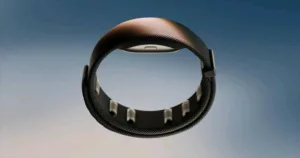When you purchase through links on our site, we may earn an affiliate commission. This doesn’t affect our editorial independence.
The development of the smartphone has been truly revolutionary. Starting as simple tools for communication, they quickly evolved into portable computers that transformed our lives, jobs, and relationships. Meta’s Ray-Ban Glasses and Neural Band are reminiscent of the introduction of the iPhone in 2007. It marked a pivotal moment, bringing forth the touchscreen age and merging communication, entertainment, navigation, and commerce into one device. Throughout the years, smartphones have become essential digital connections. They have radically transformed industries and social communication from what they were. They have become so ingrained in everyday life that picturing a world without them seems unimaginable.
New Wearables Launch at Meta Connect
On September 17, 2025, at Meta Connect, Mark Zuckerberg presented what might be a preview of that world: the Meta display Glasses, the Ray-Ban Vanguard Glasses and the Meta Neural Band. In contrast to the smartphone that fits inside our pockets, these glasses offer easy and concise interactions, providing instant translations or a navigation guide. At the same time, the Neural Band converts subtle muscle signals into comprehensive data about the health and other vital signs of the wearer. This emerging technology raises the question: are we seeing the start of the post-smartphone age, or merely another unsuccessful experiment with a wearable technology?

Image credit: Instagram
What distinguishes these glasses from past failures is their focus on improving, not substituting, real-world interaction. Rather than the intense immersive overlays that disconnect users from their environment, Meta chose a different approach. A side-mounted screen activates only when necessary. When activated, it enables users to translate conversations, view images, or navigate without disrupting their movement. With this measured strategy, Meta might have unlocked the secret to making augmented reality fashionable and socially embraced. It has included features that were lacking in prior efforts, such as Google Glass.
The Neural Band: Cutting-edge Wearable Device
The Neural Band enhances the experience significantly. Worn around the wrist, it converts subtle muscle signals into digital commands, allowing for scrolling, clicking, and navigating through gestures that are so delicate they are almost imperceptible. It resembles computing, which is almost managed by thoughts. Aside from its novelty, this technology carries significant implications for inclusivity, providing fresh methods for individuals with mobility issues or tremors to engage with devices. It hints at a future with less intrusive and more readily available technology.

Image credit: Oakley
The glasses and Neural Band collectively address the smartphone’s most significant weakness: its requirement for constant focus. Rather than retrieving a device, unlocking it, and gazing at a bright screen, information now appears momentarily at the periphery of your sight before disappearing. You can manage messaging, translation, or video calls without using your hands, whether walking on a busy street or preparing food in your kitchen. Technology shifts from being a rival for attention to becoming a subtle presence in everyday life.
The Social Consequences of a Post-Smartphone World
The social consequences are equally significant. Smartphones have gained a reputation for separating individuals even in communal areas, the well-known scene of friends at a table, each focused on their device. Glasses imply an alternate dynamic, facilitating subtle, lightweight interactions that permit conversations to proceed smoothly. By integrating effortlessly into everyday life, they advocate for technology that enhances presence rather than detracting from it.
Certainly, challenges are everywhere. Glasses still lack the adaptability of a bigger screen for browsing, streaming, or editing documents, which remain essential to numerous daily routines. Privacy issues will influence adoption since glasses with cameras will inevitably lead to questions regarding surveillance and consent. Battery longevity, resilience, and cost-effectiveness continue to be obstacles. Currently, the ecosystem relies significantly on Meta’s platforms, restricting its universality in a landscape where individuals use various apps and services.
Feasibility of Glasses as Smartphone Substitutes
Nevertheless, history indicates that these kinds of restrictions are not detrimental. The initial smartphones were bulky and costly and regarded as unneeded until they became essential. Glasses might take a similar route: starting as smartphone companions and eventually integrating their capabilities. They can manage messaging, navigation, and photography without using a handset. As display, AI, and ecosystem integration enhance, the equilibrium might eventually shift.
One of the most notable aspects of Meta’s strategy is its focus on design. The company has sidestepped the futuristic look that plagued previous wearable technology through its collaboration with Ray-Ban. These glasses seem recognisable, even stylish. If Meta can make them as fashionable as they are helpful, acceptance might grow faster than critics anticipate.
The importance of the Ray-Ban Display glasses is not in the swift demise of the smartphone but in reshaping how we interact with technology. Focusing on presence rather than immersion and subtlety instead of distraction, Meta presents a view of digital existence in which devices recede into the background instead of dominating attention. Although smartphones may continue to reign for many years ahead, this change in expectations could be transformative, encouraging the industry to create tools that complement human attention instead of conflicting with it.
The countdown to a new age of personal technology may not conclude with these glasses, but it has undoubtedly started.









